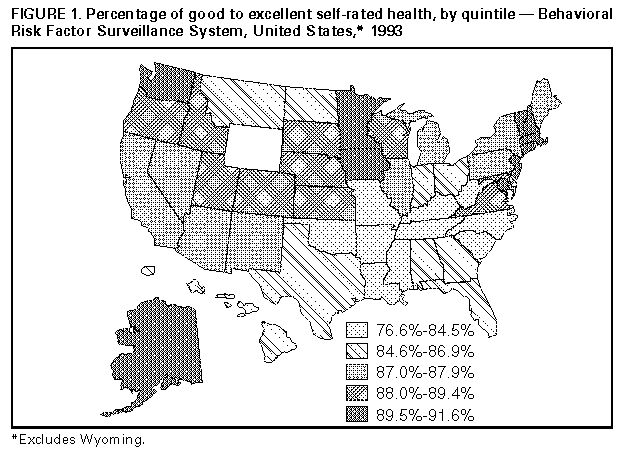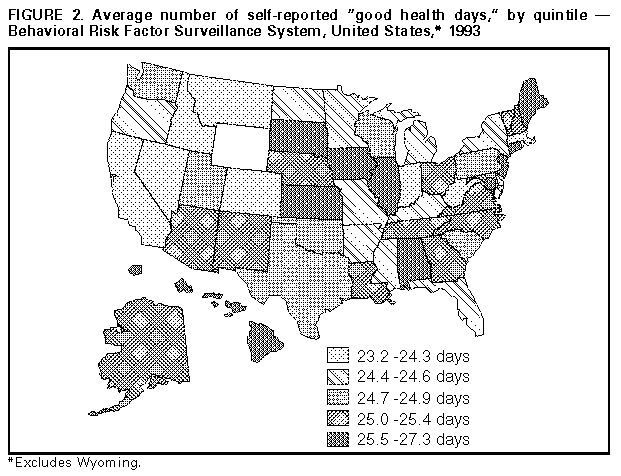 |
|
|
|
|
|
|
|
|
|
|
|
|
|
|
|
|
||||
| ||||||||||
|
|
|
|
Health-Related Quality-of-Life Measures United States, 1993Measures of health-related quality of life (HR-QOL) are used to evaluate the outcomes of interventions and the need for health services (1,2). HR-QOL includes how persons perceive their own health -- which reliably predicts loss of function, morbidity, and mortality (3-5) -- and how well they function physically, psychologically, and socially during usual daily activities. Measures of HR-QOL are important because they assess dysfunction and disability not reflected by standard measures of morbidity and mortality. Since January 1993, the Behavioral Risk Factor Surveillance System (BRFSS) has included four HR-QOL questions regarding overall self-rated health and recent physical health, mental health, and activity limitation (6). This report describes 1993 BRFSS results for state-specific differences in these measures of HR-QOL. The BRFSS is a continuous, random-digit-dialed telephone survey of the U.S. noninstitutionalized population aged greater than or equal to 18 years. In 1993, a total of 102,263 respondents living in the District of Columbia and all states except Wyoming participated in the survey. Participants were asked 1) whether their health was generally excellent, very good, good, fair, or poor; 2) how many days during the previous 30 days their physical health was not good because of injury or illness; 3) how many days during the previous 30 days their mental health was not good because of stress, depression, or "problems with emotions"; and 4) how many days during the previous 30 days their physical or mental health prevented them from performing usual activities, such as self-care, work, or recreation. Response rates for these questions ranged from 98.3% to 99.8%. Responses were analyzed to estimate state-specific percentages and means. A state-specific index of "good health days" (GHDs) was calculated by subtracting the sum of a respondent's "not good" physical health days and "not good" mental health days from 30 days, provided the number of GHDs was not less than zero (6). * GHDs represented the days during the previous 30 days for which a respondent did not report any physical or psychological dysfunction. Because these measures are associated with age and sex, the crude estimates were adjusted by 5-year age group and by sex to the July 1, 1990, U.S. population (7). However, only the crude measures are presented because adjustment did not substantially affect the geographic patterns for any of the HR-QOL measures. All percentage or mean estimates and their 95% confidence intervals (CIs) were calculated using SUDAAN (8). Spearman rank correlations (rs) were calculated between pairs of estimates of the measures for each state (9). Overall, 86.6% (95% CI=86.3%-86.9%) of respondents reported good to excellent self-rated health. Percentages ranged from 76.6% (West Virginia) to 91.6% (Alaska) Table_1 and were highest in New Hampshire, Vermont, Massachusetts, Connecticut, New Jersey, the District of Columbia, Iowa, Minnesota, Washington, and Alaska Figure_1. The overall mean number of days of good physical health during the previous 30 days was 27.0 (95% CI=27.0-27.1) (range: 25.9 days {West Virginia} to 28.4 days {District of Columbia}) Table_1, and numbers were highest in Connecticut, the District of Columbia, Iowa, Kansas, South Dakota, Alaska, and Hawaii. Reported good to excellent self-rated health was correlated with good physical health (rs=0.57; p less than 0.01). The overall mean number of days of good mental health during the previous 30 days was 27.1 (95% CI=27.1-27.2) (range: 26.0 days {Nevada} to 28.6 days {District of Columbia}) Table_1; numbers were highest in Maine, Connecticut, New Jersey, the District of Columbia, Alabama, Illinois, Iowa, South Dakota, New Mexico, and Hawaii. The mean number of days of good mental health was correlated with good physical health days (rs=0.66; p less than 0.01) but not with good to excellent self-rated health (rs=0.10; p=0.47). The overall mean number of days without activity limitations during the previous 30 days was 28.3 (95% CI=28.2-28.4) (range: 27.3 days {Kentucky and West Virginia} to 29.3 days {District of Columbia}) Table_1. The highest numbers were reported in Maine, New Hampshire, Connecticut, Maryland, the District of Columbia, Iowa, North Dakota, South Dakota, Kansas, and Hawaii. The mean number of days without activity limitations was correlated with the other three HR-QOL measures and most strongly with the mean number of days of good physical health (rs=0.80; p less than 0.01). The mean number of GHDs in the entire sample was 24.8 (95% CI=24.7-24.9) (range: 23.2 days {Nevada} to 27.3 days {District of Columbia}) Table_1. The geographic pattern of GHDs was a composite reflecting the patterns for good physical and mental health days Figure_2. The GHD pattern differed from the pattern of good to excellent self-rated health Figure_1 because the latter was more strongly correlated with good physical health days than with good mental health days. These patterns persisted when the maximal overlap GHD index was used. Reported by: BRFSS coordinators S Jackson, MPA, Alabama; P Owen, Alaska; B Bender, Arizona; J Senner, PhD, Arkansas; B Davis, PhD, California; M Leff, MSPH, Colorado; M Adams, MPH, Connecticut; F Breukelman, Delaware; C Mitchell, District of Columbia; D McTague, MS, Florida; E Pledger, MPA, Georgia; F Newfield, MPH, Hawaii; C Johnson, MPH, Idaho; B Steiner, MS, Illinois; R Guest, MPH, Indiana; P Busick, Iowa; M Perry, Kansas; K Bramblett, Kentucky; D Hargrove-Roberson, MSW, Louisiana; D Maines, Maine; A Weinstein, MA, Maryland; R Lederman, MPH, Massachusetts; H McGee, MPH, Michigan; N Salem, PhD, Minnesota; E Jones, MS, Mississippi; J Jackson-Thompson, PhD, Missouri; P Smith, Montana; S Huffman, Nebraska; E DeJan, Nevada; K Zaso, MPH, New Hampshire; G Boeselager, MS, New Jersey; P Jaramillo, MPA, New Mexico; C Maylahn, MPH, New York; G Lengerich, VMD, North Carolina; D Young, MS, North Dakota; E Capwell, PhD, Ohio; N Hann, MPH, Oklahoma; J Grant-Worley, MS, Oregon; J Romano, MPH, Pennsylvania; J Hesser, PhD, Rhode Island; M Lane, MPH, South Carolina; B Miller, South Dakota; D Ridings, Tennessee; R Diamond, MPH, Texas; R Giles, Utah; R McIntyre, PhD, Vermont; S Carswell, MA, Virginia; K Holm, MPH, Washington; F King, West Virginia; E Cautley, MS, Wisconsin. Aging Studies Br, Div of Chronic Disease Control and Community Intervention, and Behavioral Risk Factor Surveillance Br, Office of Surveillance and Analysis, National Center for Chronic Disease Prevention and Health Promotion, CDC. Editorial NoteEditorial Note: As life expectancy increases, the prevalence of impaired health and function also may increase. The 1993 BRFSS findings indicate substantial state- specific variation in HR-QOL; some states ranked consistently high for all four measures, while others ranked consistently low. Of the four measures, the percentage of respondents with good to excellent self-rated health varied the most, and the mean number of days without activity limitation varied the least; the former, therefore, may be a more sensitive indicator of differences in factors that affect HR-QOL or of differences in attitudes toward health. The percentage of respondents with good to excellent self-rated health is more consistently related to the mean numbers of days of good physical health and of days without activity limitation than to the mean number of days of good mental health. Evaluation of mental health, therefore, complements the evaluation of physical health and self-rated health in the assessment of HR-QOL (1,6). Although age and sex are strongly correlated with the four measures used in this report (6), they did not fully account for state-to-state variation. Other unassessed factors that may have accounted for this variation include education level, income, employment status, marital status, health-care coverage, cigarette smoking, and contextual influences (including culture, social support, perceived neighborhood safety, and environmental hazards). For example, because of cultural influences, some respondents may have been less willing to acknowledge or report health problems to strangers. In addition, these findings may have overestimated the prevalence of HR-QOL because BRFSS did not include some groups (e.g., institutionalized persons, homeless persons, and other persons without telephones). Finally, this analysis did not differentiate variations within states or within groups. The BRFSS supplies timely information for monitoring health status at the state level. Measuring HR-QOL assists in monitoring progress toward the overall goal of the national health objectives for the year 2000 to increase the span of healthy life (10) and may enable states to identify persons with low perceived HR-QOL. Refinement of HR-QOL measures will require validation of these measures and clarification of their relation to risk factors. References
* Although computation of GHDs assumes a minimal overlap of "not good" health days reported, an alternative index that assumed maximal overlap added only 0.4 mean days to the 24.8 overall mean number of days of the minimal overlap of GHDs. Table_1 Note: To print large tables and graphs users may have to change their printer settings to landscape and use a small font size.
TABLE 1. Responses to health-related quality-of-life questions, by state -- Behavioral
Risk Factor Surveillance System, United States, * 1993
================================================================================================================
Mean % respondents
with good to Mean no. days Mean no. days Mean no. days
excellent of good of good without activity Mean no.
State self-rated health + physical health & mental health & limitations @ good health days **
--------------------------------------------------------------------------------------------------------------
Alabama 85.3 27.4 28.2 28.5 26.2
Alaska 91.6 27.7 27.3 28.6 25.3
Arizona 87.5 27.1 27.0 28.3 25.0
Arkansas 80.3 26.5 27.4 27.7 24.5
California 87.0 26.8 26.5 28.0 24.1
Colorado 88.9 27.0 26.6 28.5 24.1
Connecticut 90.0 27.7 27.8 28.8 25.8
Delaware 87.2 26.7 26.8 28.3 24.1
District
of Columbia 89.9 28.4 28.6 29.3 27.3
Florida 84.6 26.8 26.8 28.2 24.4
Georgia 86.3 27.4 27.4 28.5 25.3
Hawaii 86.2 27.8 27.9 28.9 26.1
Idaho 88.1 26.7 26.8 28.5 24.1
Illinois 87.4 27.3 27.8 28.6 25.6
Indiana 85.3 26.5 27.0 28.3 24.2
Iowa 90.7 27.6 27.7 28.9 26.0
Kansas 88.0 27.8 27.6 28.9 25.8
Kentucky 79.9 26.2 27.4 27.3 24.5
Louisiana 83.9 27.2 27.4 28.4 25.2
Maine 87.4 27.4 27.8 28.7 25.7
Maryland 89.2 27.3 27.4 28.7 25.2
Massachusetts 89.6 26.9 26.8 28.2 24.3
Michigan 87.0 27.1 26.9 28.5 24.4
Minnesota 89.6 27.1 26.8 28.4 24.5
Mississippi 78.4 26.7 27.0 27.9 24.5
Missouri 83.8 26.8 27.0 28.3 24.5
Montana 86.5 26.5 27.0 28.2 24.0
Nebraska 88.0 27.2 27.4 28.6 25.1
Nevada 87.0 26.5 26.0 28.1 23.2
New Hampshire 90.8 27.4 26.9 28.7 25.0
New Jersey 90.8 27.4 27.7 28.5 25.5
New Mexico 87.4 27.3 27.7 28.5 25.3
New York 87.6 26.9 26.9 28.3 24.4
North Carolina 82.8 26.8 27.6 28.3 25.0
North Dakota 86.4 27.0 26.9 28.7 24.4
Ohio 86.3 27.0 27.3 28.5 25.0
Oklahoma 82.9 26.9 27.2 28.4 24.8
Oregon 88.0 27.0 27.0 28.1 24.5
Pennsylvania 87.2 27.0 27.2 28.2 24.7
Rhode Island 85.2 26.5 26.8 28.4 24.0
South Carolina 82.7 27.2 27.3 28.3 24.9
South Dakota 89.4 27.5 28.1 28.7 26.1
Tennessee 81.5 26.9 27.3 28.4 25.1
Texas 86.0 27.2 27.1 27.6 24.9
Utah 88.4 27.0 27.2 28.2 24.7
Vermont 89.5 27.2 27.2 28.6 25.0
Virginia 89.0 27.4 27.3 28.5 25.1
Washington 90.5 27.1 27.0 28.5 24.8
West Virginia 76.6 25.9 27.0 27.3 24.0
Wisconsin 89.0 27.0 27.3 28.4 24.8
Total 86.6 27.0 27.1 28.3 24.8
--------------------------------------------------------------------------------------------------------------
* Excludes Wyoming.
+ Standard error +/-1.2%.
& Standard error +/-0.3 days.
@ Standard error +/-0.2 days.
** Standard error +/-0.4 days.
================================================================================================================
Return to top. Figure_1  Return to top. Figure_2  Return to top. Disclaimer All MMWR HTML versions of articles are electronic conversions from ASCII text into HTML. This conversion may have resulted in character translation or format errors in the HTML version. Users should not rely on this HTML document, but are referred to the electronic PDF version and/or the original MMWR paper copy for the official text, figures, and tables. An original paper copy of this issue can be obtained from the Superintendent of Documents, U.S. Government Printing Office (GPO), Washington, DC 20402-9371; telephone: (202) 512-1800. Contact GPO for current prices. **Questions or messages regarding errors in formatting should be addressed to mmwrq@cdc.gov.Page converted: 09/19/98 |
|||||||||
This page last reviewed 5/2/01
|